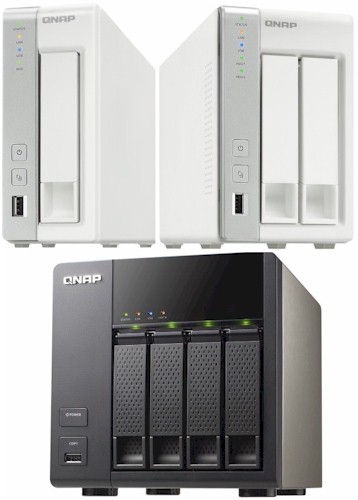
| At a Glance | |
|---|---|
| Product | QNAP TS-x20 Turbo NAS Series [Website] |
| Summary | Marvell-powered Home and SOHO NAS line |
| Pros | • USB 3.0 & eSATA ports • Cloud backup to Amazon S3, ElephantDrive, Symform |
| Cons | • Pricey compared to other Marvell-based NASes |
Introduction
Now that we have the NAS Ranker, it’s SmallNetBuilder’s mission to get more NASes into our database so that you have more products to compare when it’s time to go shopping. QNAP made it a bit easier for me with the launch of its TS-x20 and TS-x21 NASes in April.
The six desktop models in the two lines share a common Marvell-powered platform with only processor clock speed separating them. So I figured I’d use the four-bay versions of each line and run tests with one, two and four drives to cover the entire line.
This review applies to the TS-120, TS-220 and TS-420 one, two and four-bay models. The TS-421 review covers only that product because I wasn’t so smart a few weeks ago when I posted that review. So I’ll be following up with a short review of the TS-121 and 221 soon. In the meantime, all six models are already in the NAS Charts, Finder and Ranker.
All four members of the TS-x20 series models have 1.6 GHz single-core Marvell CPUs with 512 MB of DDR3 RAM and 16 MB of flash. Both lines include four-bay rackmount servers (TS-420U, TS-421U).
For the most part, the TS-X20s look similar to their TS-X21 cousins. The differences are that the TS-420 has no LCD status panel and the TS-220 and TS-120 are white instead of black.

QNAP TS-420 Front and rear panel callouts
The TS-420’s callouts are in the image above and the rear panels of the three models are arranged side-by-side below.
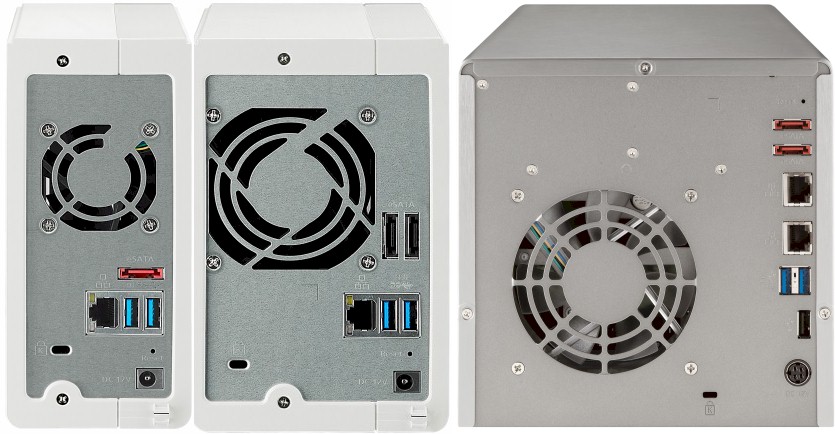
QNAP TS-x20 & x21 series rear panels
A summary of the each model’s ports is in Table 1.
| TS-120 / 121 | TS-220 / 221 | TS-420 / 421 | |
|---|---|---|---|
| USB 2.0 | 1 | 1 | 2 |
| USB 3.0 | 2 | 2 | 2 |
| eSATA | 1 | 2 | 2 |
| Ethernet | 1 | 1 | 2 |
Table 1: Port summary
Inside
I didn’t bother trying to wrestle the TS-420’s main board from its cabinet. A quick peek after I removed the cover told me it was the same as the TS-421’s main board with a 1.6 GHz Marvell 88F6282 Kirkwood SoC substituted for the 2.0 GHz version used in the x21 models and 512 GB of onboard DDR3 RAM vs. the 1 GB in the x21s.
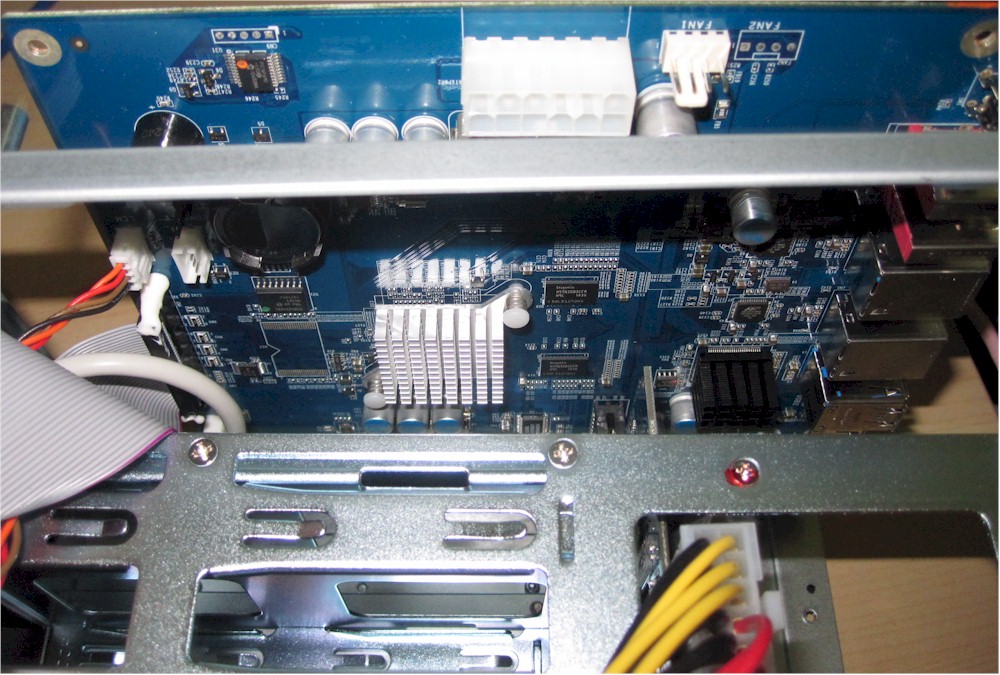
Partial view of QNAP TS-421 / TS-420 board
Both the TS-420 and TS-421’s CPUs have a heatsink. Table 2 summarizes key components for the TS-420, TS-421 and older TS-412.
| TS-421 | TS-420 | TS-412 | |
|---|---|---|---|
| CPU | Marvell 88F6282 Kirkwood SoC @ 2 GHz | Marvell 88F6282 Kirkwood SoC @ 1.6 GHz | Marvell 88F6281 Kirkwood SoC @ 1.2 GHz |
| RAM | 1 GB DDR3 | 512 MB DDR3 | 256 MB DDR2 |
| Flash | 16 MB | 16 MB | 16 MB |
| Ethernet | Marvell Alaska 88E1318 (x2) | Marvell Alaska 88E1318 (x2) | Marvell Alaska 88E1116R (x2) |
| USB 3.0 | Etron Tech EJ168A | Etron Tech EJ168A | N/A |
| SATA | Marvell 88SX7042 | Marvell 88SX7042 | Marvell 88SX7042 |
Table 2: Key component summary and comparison
The NAS was equipped for testing with our standard four Western Digital Red 3TB drives (WD30EFRX). Power consumption measured 27 W with the 4 drives spun up and 13 W with them spun down. Fan and drive noise could be classified as low, i.e. barely audible in my quiet home office.
Features
See the TS-421 review and Craig’s in-depth look at QTS 4.0.
Performance – Summaries
4.0.1 firmware was loaded on the TS-420 for our standard NAS test process. As noted earlier, all testing was done on the TS-420 sample. The TS-420 tests used four drives configured in single RAID 0, 5 and 10 volumes. The TS-220 tests used two drives in single RAID 0 and 1 volumes. The TS-120 tests used one drive.
As I found with the TS-421, times to completely build and resync 4 x 3 TB RAID 5 and 10 volumes were quite long at 17h 20m and 23h 5m, respectively. Build and resync for 2 x 3 TB RAID 0 and 1 volumes were 32 minutes and two hours, respectively. Unlike Thecus and Synology, QNAP does not offer the option to skip a bad block test, which can speed volume resync times significantly.
Since we have the NAS Ranker, I’ll only make a few observations about each benchmark summary. The TS-420’s below shows best file copy throughput with RAID 0 (53 MB/s) and worst with RAID 5 (34 MB/s). Read is best again for RAID 0 (79 MB/s) with both RAID 5 and 10 read about 10 MB/s lower. NASPT file copy write performance is lower across the board for write and about the same for read.
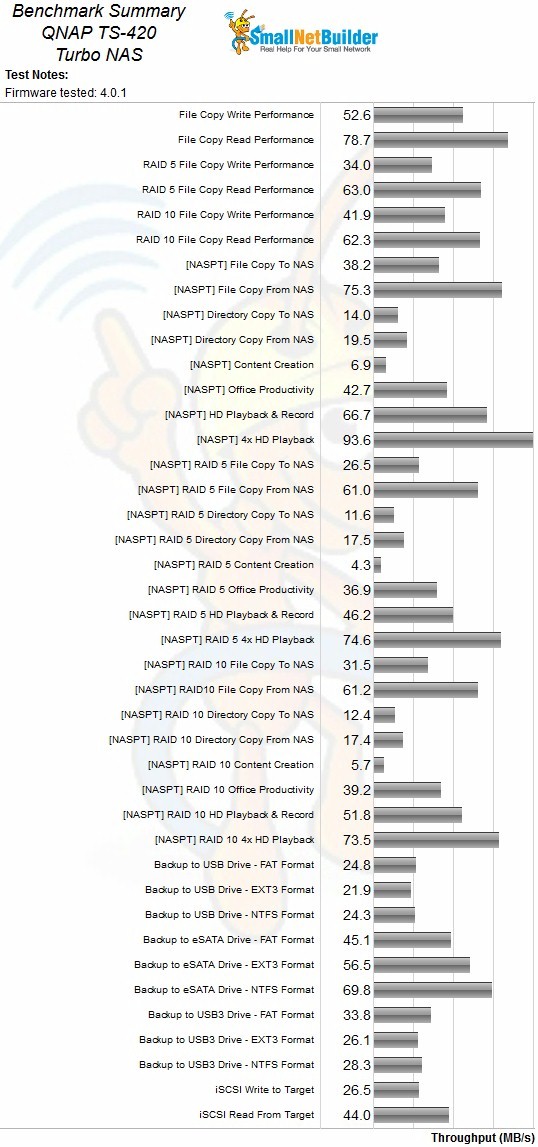
QNAP TS-420 Benchmark Summary
I was not able to run the Network backup (rsync) tests on the TS-420 because QNAP has not fixed the bug that prevents selecting a remote target directory yet.
With two drives representing the TS-220’s performance, RAID 0 performance is in the same ballpark as with four drives. Windows file copy for RAID 1 measured 42 MB/s for write and 66 MB/s for read. NASPT file copy was a tad lower (40 MB/s) for write and almost 15 MB/s higher for read.
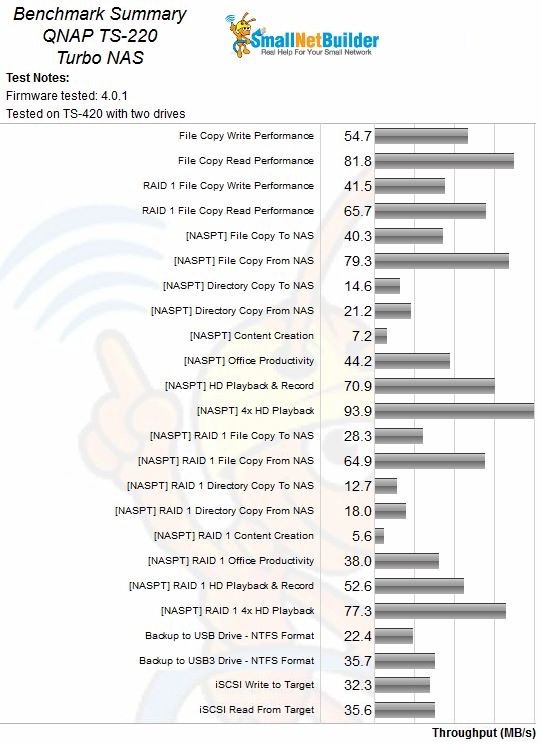
QNAP TS-220 Benchmark Summary
With only a single drive, both write and read performance dipped to 46 and 70 MB/s for Windows file copy and 33 MB/s and 65 MB/s for NASPT file copy.
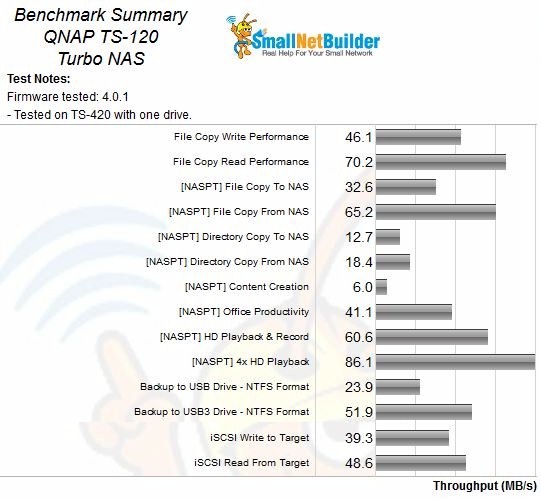
QNAP TS-120 Benchmark Summary
Performance – Ranking
Since the ranker groups products only by processor class, we need to scan the SoC-1 (single core application-specific processors) class rankings to find the relative ranking for products with the same number of bays. For four-bay RAID 5 products, we find the TS-420 in the #4 slot, which is the best for four-bay NASes in this class. Surprisingly, the TS-421 ranks at #11 (tied with the TS-121), with Synology’s DS413j as the only other four-bay NAS between them.
Put another way, the TS-420 is in the #1 slot for four-bay SoC-1 class NASes and the TS-421 is ranked #3. So why? Comparing the Ranker Performance summaries, the standout differences between the 421 and 420 are Windows FileCopy write (45 vs. 53 MB/s), Windows FileCopy Read (65 vs. 79 MB/s), NASPT FileCopy Read (59 vs. 75 MB/s), Video Playback (71 vs. 95 MB/s) and USB 3 – NTFS backup (46 vs. 28 MB/s). In the 421’s favor, it slightly outperforms the 420 on many of the other benchmarks. But when the performance goes the other way, it goes big, pushing the 421 down in the ranking.
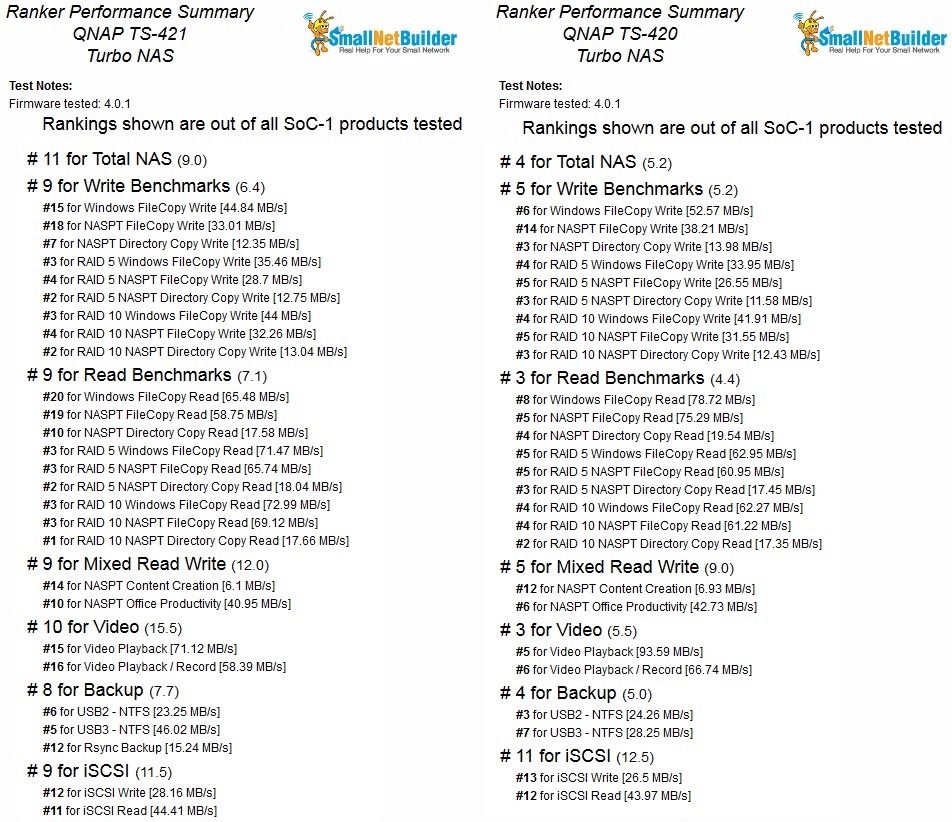
NAS Ranker Performance summary QNAP TS-421 & TS-420
Among all SoC-1 class products, the TS-220 at #6 outranks the TS-221 at #7. Looking at only two-bay NASes, the TS-220 and TS-221 rank at #5 and #6. The differences this time are less striking and amount to small differences in numerous benchmarks that all add up. Again, however, it’s the less expensive and supposedly lower-powered TS-220 that comes out on top.
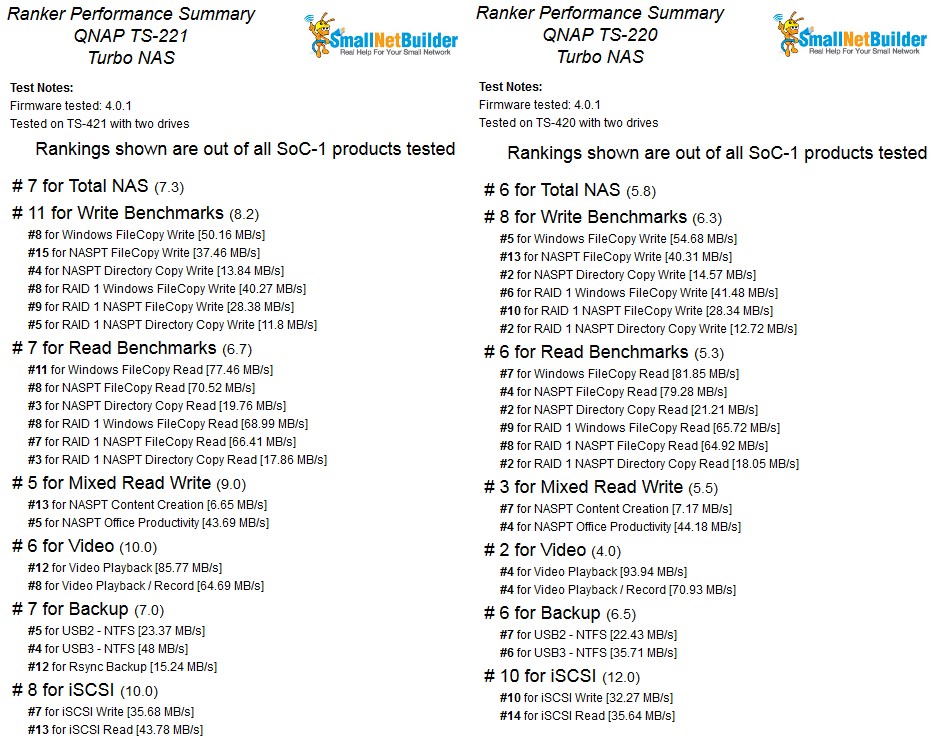
NAS Ranker Performance summary QNAP TS-221 & TS-220
Finally, for single bay SoC-1 class NASes, the TS-121 at #11 (tied with the TS-421) finally outranks its less-expensive TS-120 cousin tied at #14 with the older TS-412. Among only single-bay SoC-1 class products, the TS-121 ranks first, with the TS-120 third-ranked with the older TS-112 between them.
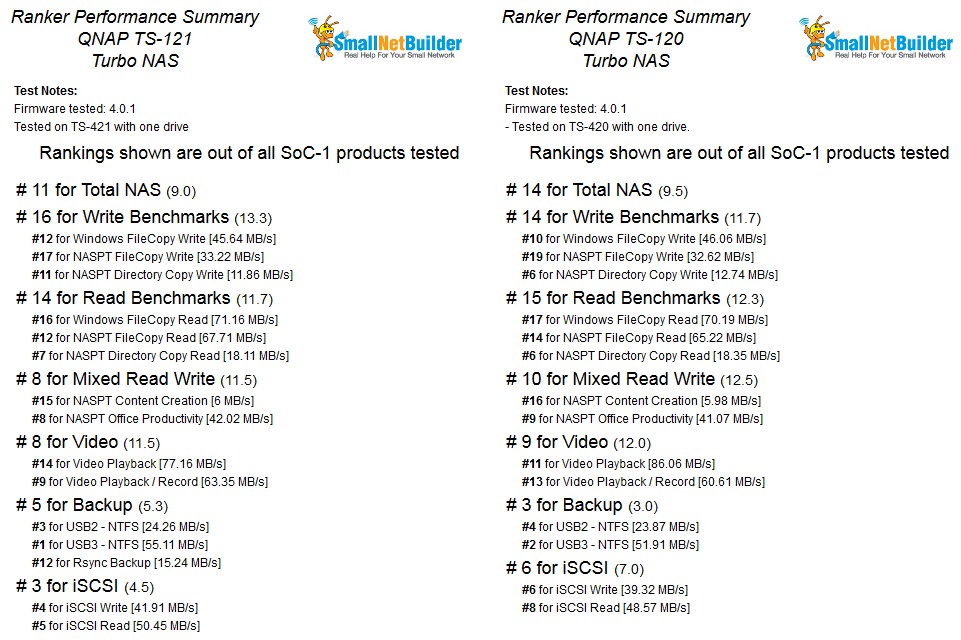
NAS Ranker Performance summary QNAP TS-121 & TS-120
Looking at the Ranker Performance summary comparison above, the difference in ranking again comes down to small differences that all add up. The biggest difference that jumps out at me is the TS-120’s 86 MB/s Video playback vs. the TS-121’s 77 MB/s. Otherwise, these two NASes are about the same as you can get.
Conclusion
QNAP is known for having a lot of NASes to choose from. And in this case, it just seems like too many. By our testing, paying a premium for the TS-x21 series with its slightly higher processor speed and 1 GB vs. 512 MB of RAM just doesn’t seem worth it. The premium you pay depends on how well you shop. But it can be significant in percentage as Table 3 shows.
| TS-x20 | TS-x21 | x21 premium | |
|---|---|---|---|
| One bay | $169 | $220 | 30% |
| Two bay | $219 | $321 | 47% |
| Four bay | $413 | $480 | 16% |
Table 3: The x21 premium
(all prices from Pricegrabber on 7/29/13)
There may be scenarios where paying the premium might be worth it. But if it were our money, we’d opt for the x20 versions and pocket the difference.
